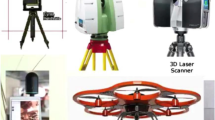Abstract
Aiming at the defects of routine settlement measurement methods, such as complicated procedures, time-consuming and labor-intensive, high cost and low measurement accuracy, based on the analysis of existing engineering measurement technical requirements and specifications, a multi-point high precision and high efficiency based on laser reference is proposed. The automatic building settlement real-time monitoring system program gives the principle and system model of single-point settlement observation. The model of multi-point scanning settlement monitoring system and the model of multi-point network settlement monitoring system are designed, and their advantages and disadvantages are analyzed. We focus on the networked multi-point settlement monitoring system for network cumulative error analysis, and propose related evaluation and correction methods. The hardware schematic and software block diagram of the laser reference measurement and measurement system of the single point settlement acquisition system are given. Finally, the risk of subsidence state is quantitatively evaluated based on multi-point settlement monitoring data. The measurement error of this method is less than 300 µm, which can realize the monitoring and evaluation of the overall settlement.
Similar content being viewed by others
References
Nour A, Slimani A, Laouami N. Foundation settlement statistics via finite element analysis [J]. Computers and Geotechnics, 2002, 29(8): 641–672.
Petri R, Nuikka M, Suominen A, et al. Comparison of measurement techniques and static theory applied to concrete beam deformation [J]. The Photogrammetric Record, 2009, 24(128): 351–371.
Lee I M, Lee J S, Nam S W. Effect of seepage force on tunnel face stability reinforced with multi-step pipe grouting [J]. Tunnelling & Underground Space Technology, 2004, 19(6): 551–565.
Matsuda H, Tsutsui T, Ikeda K, et al. Application of GPS displacement measurements for monitoring slope displacements at a tunnel entrance [J]. Journal of Japan Society of Civil Engineers, 2012, 68(2): 21–28.
Bardi F, Frodella W, Ciampalini A, et al. Integration between ground based and satellite SAR data in landslide mapping: The San Fratello case study [J]. Geomorphology, 2014, 223: 45–60.
Brenot H, Lejeune S, Warnant R. Detection of small-scale structures in the neutral atmosphere using double differences of GNSS measurements [J]. Heredity, 2008, 62(3): 335–342.
Yang L, Liu J Y, Wang Y C, et al. 3D dense reconstruction based on omnidirectional camera and laser range finder [J]. Journal of Zhejiang University, 2014, 48(8): 1481–1487(Ch).
Teng Y J. Understanding and application of the concept of bearing capacity of foundation in code for design of building foundation [J]. Engineering Investigation, 2004, (3): 1–2 (Ch).
Zhang Q Q. Experimental and Theoretical Study on the Mechanical and Settlement Characteristics of Pile Foundation in Soft Soil [D]. Zhejiang: Zhejiang University, 2012(Ch).
Soman M R, Hall D J, Tutt J H, et al. Developing a CCD camea with high spatial resolution for RIXS in the soft X-ray rane [J]. Nuclear Instruments & Methods in Physics Research, 2013, 731(12): 47–52.
Yang J. Research on All-Round Monitoring Method and Technology of Roadbed Settlement [D]. Beijing: Beijing Jiaotong University, 2014(Ch).
Yoneyama S, Kitagawa A, Iwata S, et al. Bridge deflection measurement using digital image correlation [J]. Experimental Techniques, 2007, 31(1): 34–40.
Xie G Y. Research on Multi-Factor Risk Assessment Method for Mountain Bridge Construction Period [D]. Xi’an: Chang’an University, 2013(Ch).
Wu K Y, Zhang X Z, Huang Y W, et al. The feasibility study on settlement monitoring of a parallel combination prediction method based on ELMD [J]. Geomatics and Information Science of Wuhan University, 2017, 42(10): 1482–1488.
Deng Z, Ke Y H, Gong H L, et al. Land subsidence prediction in Beijing based on PS-InSAR technique and improved Grey-Markov mode [J]. Giscience & Remote Sensing, 2017, 54(06): 797–818.
Bradey C A, Rolka H, Walker D, et al. BioSense: Implementation of a national early event detection and situational awareness system [J]. Mmwr Morb Mortal Wkly Rep, 2005, 54Suppl: 11–19.
Author information
Authors and Affiliations
Corresponding author
Additional information
Foundation item: Supported by the Natural Science Foundation of Shaanxi Province (2018JM6023), and the Science and Technology Project of Shaanxi Provincial Transportation Department (17-16K,17-33T)
Biography: CHAI Caiping, female, Master candidate, research direction: civil engineering measurement and quality evaluation.
Rights and permissions
About this article
Cite this article
Chai, C., Wu, Z., Wang, H. et al. A Novel Multi-Points Laser Monitoring of Building Settlement and Its Risk Evaluation. Wuhan Univ. J. Nat. Sci. 24, 442–454 (2019). https://doi.org/10.1007/s11859-019-1420-8
Received:
Published:
Issue Date:
DOI: https://doi.org/10.1007/s11859-019-1420-8




